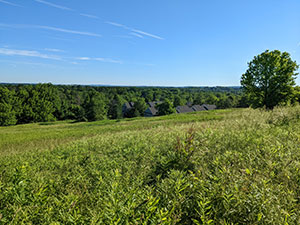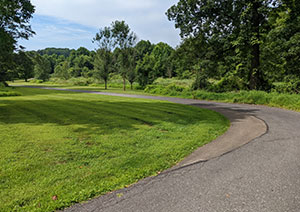Design Elements — Link Open Space on Adjacent Parcels

The open space within Charlestown Hunt, which consists of meadow and mature forest, connects with hundreds of acres of contiguous forest around the Pickering Creek, much of which is permanently protected open space
Simply providing a certain percentage of open space does not necessarily meet the intent of a conservation subdivision ordinance. If designed well, open space areas can contribute to the healthy functioning of existing ecosystems and natural processes. For example, including a wooded area that connects to woods on an adjacent parcel, or continuing a naturalized riparian buffer from an upstream parcel can enhance the functionality of the open space for wildlife, water quality, and overall environmental health.
Ordinance Considerations
Because of the site-specific nature of this design element, crafting ordinance language to achieve open space connectivity can be challenging. The best way to encourage this principal is by having a system in place for municipal representatives to visit the site with developers prior to any design work to identify goals for the site and strategies for creating open space connectivity. Strongly encouraging the submission of a sketch plan can also help achieve the desired result.
Some objectives for encouraging open space connectivity include:
- Link open space (woodlands, water, and other natural resources) on individual parcels to ensure the continuity and effectiveness of natural systems, such as stormwater management and wildlife habitat.
- Coordinate open space on adjacent parcels to create and connect to a community open space network.
- Integrate development with regional green corridors to provide movement for people and wildlife, within and beyond a development.
- Create internal open space connections.
- Provide multiple internal open space corridors for recreational or circulation routes through a development.

A trail leads from the end of a cul-de-sac street in the Lamborn Hunt development into adjacent Goddard Park.

